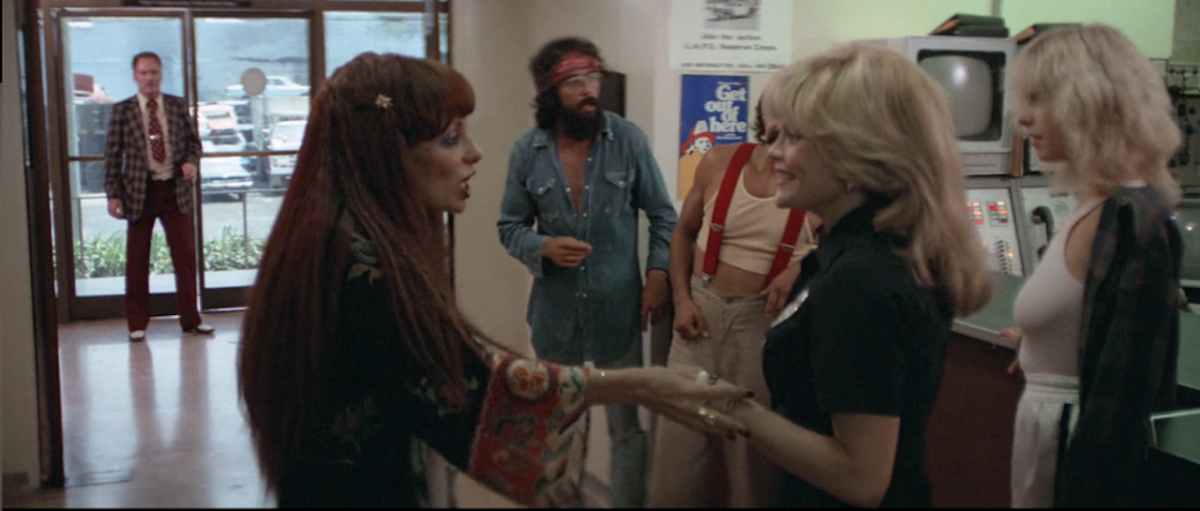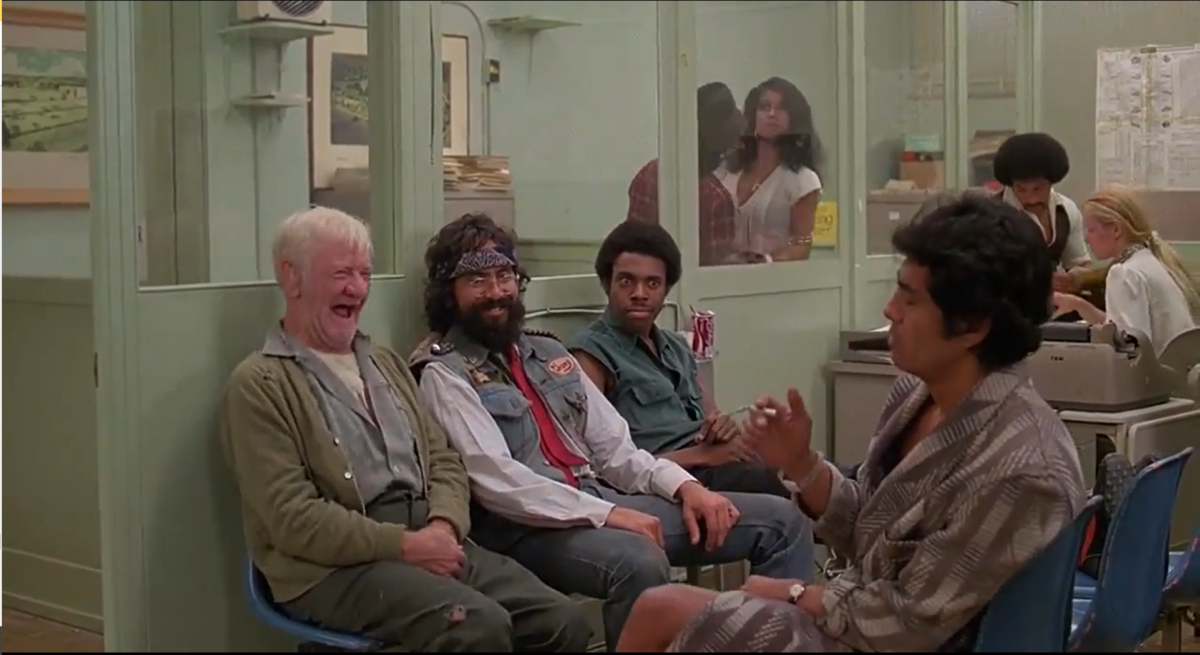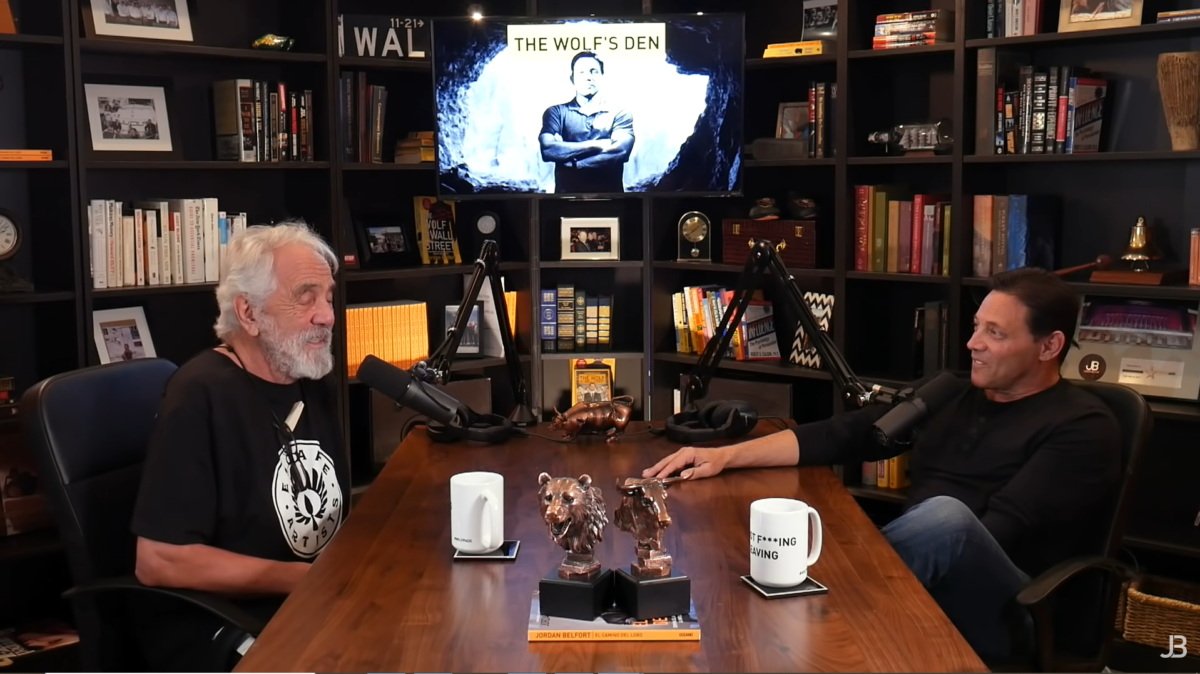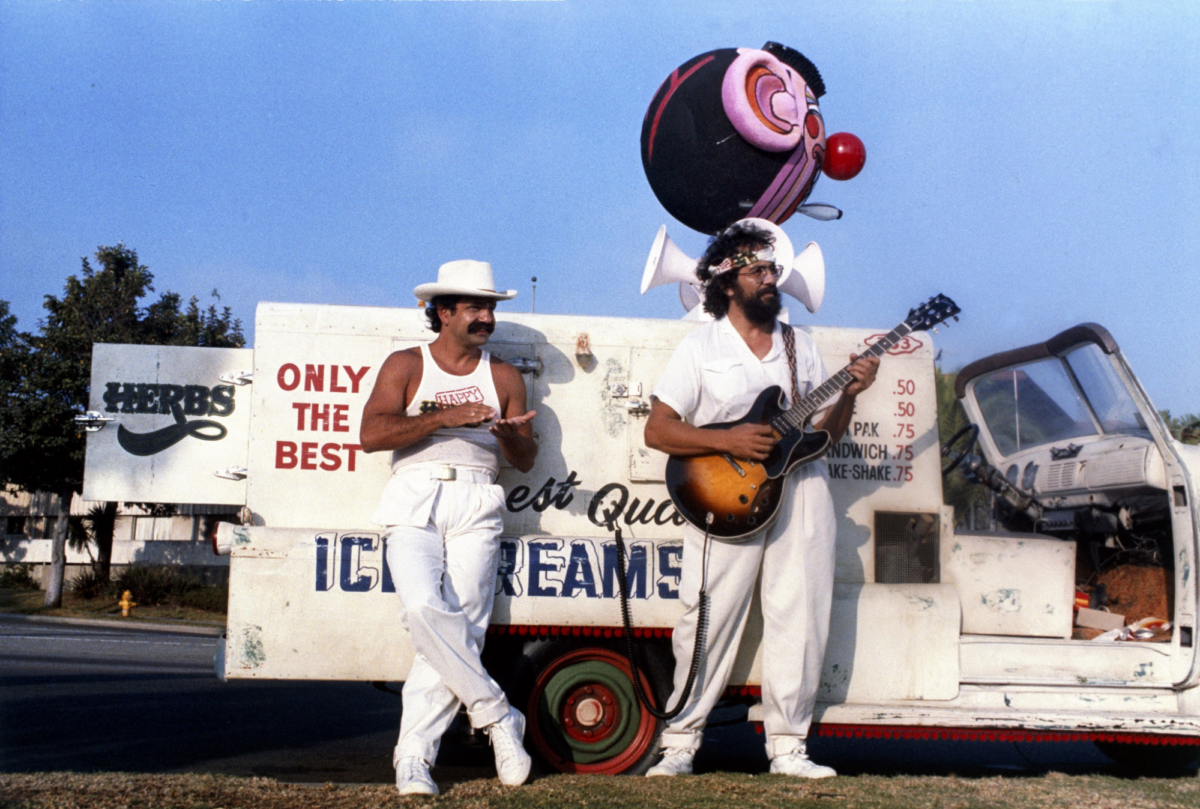I.
Tommy Chong sat at the desk in his cell, scribbling furiously into a hemp-bound notebook. His cellmate strolled in, barely a mark on his tennis shoes.
‘How was the game, man?’ asked Chong, without looking up.
‘We call it a match, old sport—I polished him off in three sets. The guards wouldn’t let us go to five.’
‘Fifteen – love. Sounds like my last orgy,’ murmured Chong in his California drawl, letting out a throaty laugh as he scribbled away. Jordan Belfort slipped out of his shoes, and tucked them under the thin, hard mattress of his bunk.
‘Say, what you writing there old sport?’
‘Its a memoir, man. You should write one too!’
Belfort took it to heart, and 6 years later, in 2013, Martin Scorsese would adapt his memoir, The Wolf of Wall Street, into a critically acclaimed and endlessly quoted film. If it is true that Chong inspired Belfort to write his memoir, as is often quoted on podcast interviews and clickbait articles, then will it prove to be his lasting cinematic legacy?
Chong and his long-time comedy partner, Cheech Marin, had worked with Scorsese 15 years before Belfort’s arrest for running a giant penny-stock scam, on After Hours (1985). In it, the pair play a recurring foil to the nebbish yuppie Paul Hackett (Griffin Dunne), as burglars whose art thefts aid in the chaotic derailment of this man’s horny aspirations over one New York night. It’s odd to see the duo in the East Coast environment, where Michael Ballhaus’ deep liquid blacks draw lines of anxiety over each actor’s face. Scorsese coyly cast the pair; in this satire of Wall Street easy living, even this couple of bums are getting to work. Cheech even gets the film’s summative line when stealing a papier-mâché sculpture unwittingly containing a horrified Hackett, ‘A stereo’s a stereo—Art is forever.’
A nice sentiment, but the apparent decline in their cultural legacy beyond branded bongs and Halloween costumes would suggest that Cheech and Chong are not themselves permanent.
II.
It should not be this way. After all, Cheech and Chong are largely credited with creating the modern Stoner Comedy. Their cycle of seven key collaborations between 1978–1985, written by the pair and largely directed by Chong, would set the template for stoner aesthetic ethos which would be used by filmmaker/comedians as disparate as Richard Linklater (Dazed & Confused (1993)), Tamra Davis (Half Baked (1998)), James Toback (Harvard Man (2001)), and Gregg Araki (Smiley Face (2007)). The formula is a simple variation of the Joseph Conrad hero’s journey. The protagonist(s), beginning in a state of altered consciousness through the imbibition of marijuana, must acquire more in an effort to attain a nirvana status. Their journey may take them across town, campus, or simply their bedroom. They will question their relationship with the drug, before eventually conquering their paranoia and settling back on the couch with a freshly loaded bong. They will be enlightened, and they may have even grabbed the girl, but they will very much have regained their weed smoking mojo.
Time-image is cold turkey’d into Action-image. Functionally, the stoner comedy is therefore intrinsically tied to labour. The protagonist will want to rest, but be forced into action, with their altered state exacerbating the difficulty of the task. In Harold & Kumar Go to White Castle (2004), the duo played by Jon Cho and Kal Penn swap zoot suits for white collars in a millennial spin on Cheech and Chong in which they travel across New Jersey on a Quixotic search for a specifically appealing brand of hamburger (As, respectively, a banker and a medical student, their brand of stonerism is geared towards the already wealthy—weed for the higher classes as proven when Penn hilariously left acting to become a staffer in the Obama White House). Their wish to be idle stoners is the film’s overall goal, which is framed as virtuous only because they are both smart and wealthy. They are the correct type of stoner.
Cheech and Chong, on the other hand, had the perfect story for their time. They had met in Vancouver, where Marin had absconded in 1968 from Los Angeles to avoid the draft. He found himself in the nightclub City Works, which was owned and run by the Chong family. They developed as a double act in this setting, entertaining crowds between topless go-go acts with various characters from dogs who sniff each other’s backsides to parodies of local politicians and early versions of the ‘Man’ personas that they would take into the films. This was the exact alchemy which produced Cheech and Chong: two young hippies in the midst of the counterculture movement of the late 1960s, forced by their surroundings to perform a version of vaudeville theatre.
Soon, they were spotted by Lou Adler, the record producer behind Carole King and Robert Altman’s Brewster McCloud (1970), who packaged and sold the pair as anti-establishment figures. On its surface, Stoner Comedy may promote the ideals of idleness, but as their films would reveal, there is nothing radical about the politics of Cheech and Chong; two strivers who will follow the money and turn each situation into a new hustle.
III.
To begin with, the stoner film must take an underdog position. It is inherently about the wish to remain idle (being high) being scuppered by the tool which makes one idle (either by lack of or adverse reaction to marijuana). I.E. the difference between a Gaspar Noé and an Albert Serra joint. Therefore, the viewer cannot watch Cheech and Chong enjoying themselves without interruption, without fear that the high will wear off.
In their first film, Up in Smoke (1978), this underdog decree holds true. Directed by Adler, Chong plays Anthony Stoner (referred to as ‘Man’) a rich kid dropout who hitches a ride from Marin’s Chicano wannabe-playboy Pedro De Pacas, by stuffing padding in his shirt and pretending to be a woman. Soon firm friends, they have so little to their name that they are forced to smoke literal dog faeces—even if it is in a comically oversized joint. This, proto-Divine moment has a genuine originality to it, the feeling that these two mens’ ids will lead them to any level of debasement.
From this gross-out moment, and their subsequent arrest, the pair head via a bus built of weed into sex comedy territory. Then, to offset their non-stop pleasure, Adler introduces a parallel narrative of pain via the cops on their tail. Headed up by a committed Stacey Keech as Sgt. Stedenko, these scenes show the law in agony as they haplessly search for the weed that’s smoking right before their eyes, at one point accusing a group of nuns of being drug smugglers. Keech plays this dead straight as he fumes at slideshow images of mary-jane, never leaning into a punchline in a perfect parody of Nixon-era law & order mania.

It isn’t only the narrative that begins to generate the stoner film aesthetic, but all elements of the production. Their costumes, crop tops and hawaiians, a beanie hat on Cheech and bits of food placed around Chong’s beard. You’d see these fits on any zoomer’s tiktok, and colourful explosions of fabric smear across heavily grained up screens with a pleasant, soft expressionism. The Up in Smoke trailer describes them as ‘giving birth to Rock Comedy’, which is an apt double entendre because as the film series progress, they will lean into this more and more.
Before this, the stoner film was a more nebulous affair. Jewel Robbery (1932) found William Powell plying everyone around him with the Devil’s lettuce to get at Kay Francis; Reefer Madness (1936) gained a cult reputation for its overblown campaigning; and everything Howard Hawks made sings even sweeter if you’re high, but, in the American cinema, there was no comedy film which took as its subject the culture and effects of marijuana.
If we accept the premise that Cheech and Chong created the Stoner Comedy—or at least modernised and codified it—then why is there so little serious criticism of their work? A search through the BFI/Sight & Sound/Film Comment archives will return nothing in the way of reviews or retrospective features on their work (though many director interviews will cite Up in Smoke as a ‘guilty pleasure’) Even the esteemed Canadian publication Cinema Scope, from where Chong hails, has a notable blind spot when it comes to their native son. Troubled culture website Vice, on the other hand, has mentioned the pair 3987 times. They are a novelty group, which makes them a novelty reach for novelty acts like Vice.
In his ‘Partial History of American Screen Comedy’ for this publication, Adrian Martin defines Cheech and Chong’s oeuvre in passing as ‘ stoner-Latino films’, grouping them with The National Lampoon, and Porky’s (1981). Indeed, the comedy du frat is seeped into our stoner duo. Superficially, they share with the Frat an oblivious, lazy appeal; party films which allow the viewer to share in good times and the ability to transgress legal lines through association. But the vital difference is in the hierarchy of power which builds comedic perspective. Their antics of confusion are far more Abbot and Costello than Marx Brothers.
Frat humour has an above-it-all perspective privileging aspiration and achievement. The Marx Brothers’ one-liners are an assault which puts the comedy star as the aspirational and never faltering figure—too direct and assured to come out of Tommy Chong’s dry mouth, and far more suited coming from, say Chevy Chase in golf-comedy Caddyshack (1980).
Rather, it is 1940s and 50s double act Abbott and Costello, whose insular routines provide a Beckett-like battle between each other which displays their confusion at the wider world, and shared conclusion to navigate it together:
Costello: Look, you gotta outfield?
Abbott: Sure.
Costello: The left fielder’s name?
Abbott: Why.
Costello: I just thought I’d ask you.
Abbott: Well, I just thought I’d tell ya.
Costello: Then tell me who’s playing left field.
Abbott: Who’s playing first.
Costello: I’m not… stay out of the infield! I want to know what’s the guy’s name in left field?
Abbott: No, What is on second.
Costello: I’m not asking you who’s on second.
Abbott: Who’s on first!
Costello: I don’t know.
Abbott & Costello Together: Third base!
As far as I know, this routine wasn’t written in a haze of smoke, but it certainly set the template for Cheech and Chong’s early routines which parody vaudeville chatter. Their fear of dropping the mask to the audience or tertiary characters, would perfectly apply to the paranoiac insularity of the stoned. The Grammy nominated ‘Dave’s Not Here’ routine (1971), which was Cheech and Chong’s first hit, twisted vaudeville into an entirely modern conundrum which would prove their stoner bonafides to a mass audience:
CHONG: Who is it?
CHEECH: It’s Dave, man. Will you open up? I got the stuff with me
CHONG: Who?
CHEECH: Dave, man. Open up
CHONG: Dave?
CHEECH: Yeah, Dave
CHONG: Dave’s not here
CHEECH: What the hell? No, man, I am Dave, man. Will you…
This repetitive style of comedy has a drone-like power over the audience. The initial situation is an evidently humorous misunderstanding, then it becomes unfunny as it continues without much narrative or linguistic variation, before finally becoming funny again through sheer duration. What begins as a cheap novelty gains a horrid, surrealist property through repetition. As the sketch recurs in their films to increasingly tired effect, such as in Still Smokin’(1983) where they simply perform it on-stage to an Amsterdam crowd, or in the embarrassing reunion Cheech and Chong’s Animated Movie (2013), the scope of their project becomes clear: milking the same few routines to the tune of a multi-part film franchise, and a serious amount of merch. As this conspiratorial mindset takes hold, the incantatory properties of the sketch lose any realism, and become a ritual of self-aggrandising weed worship.
IV.
There is a blank and plainspoken visual style to the Stoner Comedy. The camera is often a static master with a few close ups, closer to the elegiac shapes of a Howard Hawkes tableau. As if to pre-empt the audience’s expectation for a real trip, man, the films often start with animated cartoon spliff for a logo, as if to say ‘Welcome to the weird’, before crashing the viewer down to earth with the evident limits of their budget. In Cheech and Chong’s Next Movie (1980), Chong uses this bathos to build a pattern of visual humour that is driven by gestural performances and detailed production design.
Using telephoto lenses to capture muttering, overlapping dialogue, Chong’s visual strategy to make his film cinematic is to mimic that great stoner of the New Hollywood, Robert Altman (Lou Alder had produced Brewster McCloud). After siphoning fuel from a trucker’s car—and unwittingly dousing themselves—the pair make a quick getaway. Chong immediately whips out a joint, which he waves around in a moment more excruciating than Hitchcock’s bomb beneath the table. Like Chuck Jones cartoons, the car explodes, leaving them soot-covered and bedraggled, Chong still toking. ‘I told you not to light that man!’ Screams Marin. Chong fires back, ‘You packed it man.’
Following this prologue, the film unfolds into a surprisingly astute depiction of the breadline in an East L.A. during the emergent punk scene. Most of the first act takes place in Cheech and Chong’s run-down condo, a sickening hovel that would make even Withnail flinch. Chong captures the misery of this surrounding in passive horror, letting them step around pizza boxes and motor parts in deep focus while fish tanks or dead plants crowd the foreground. Unemployed, broke, and desperate to get fucked up, they eventually embark on a visit to the welfare office. The rundown world of L.A. they step out to is the major innovation of the genre. The grime, dirt and sleaze is colourful and hallucinatory, a Bellona for the bong-ripped where the sun shines so bright that grass looks spray painted even while fences collapse and buildings crumble. In capturing the Sunshine state’s dichotomy of great weather and awful social infrastructure, Chong creates a stoner irony that you can see in Half Baked’s plastic colours, in How High’s critique of race in education, and certainly in Friday’s South Central soft-social realism.
One brings to mind Bazin’s edict that ‘photography ranks high in the order of surrealist creativity because it produces an image that is a reality of nature, namely an hallucination that is also a fact.’ Nowhere is this more apparent than the oner when they reach the welfare office. They push past a crowd of desperate people waving paperwork at harangued staff to find a seat in the waiting room. Cheech happens to be sleeping with a woman who works there, so he runs into a fishbowl office and begins hooking up. Chong is left in the waiting room beside a nodding-out junkie, an old man who can’t stop laughing, and a 21-year-old Michael Winslow, who performs his routine of insane noises. Winslow’s performance is superhuman, a rubber-faced human sound-board of baby noises, dog barks, and wolf whistles. This two-minute unbroken take is layered with Cheech’s background antics, creating a multivalent cacophony that pushes through the realism of their down-and-out situation, and into the realm of the unwell.

Having developed a unique and personal vision of weed-addled life over two movies, Nice Dreams (1981) would take a broad and meta-textual approach to decode the iconography of Cheech and Chong. Here, they are ‘Ice cream’ salesmen on Ocean Blvd, who may have something secret for sale. Largely, this film views them from afar. Stacey Keech returns as Sgt. Stedenko, who has developed an addiction to marijuana in the intervening years, not noticing that the drug has the side-effect of turning him slowly into a Lizard. He plots to steal the ice cream van of drugs so that he can sell it back onto the streets. Given the number of real life cases of police doing the same thing, this is one of the series’ most realistic plotlines.
Keech is magnetic once again, a stoner-antagonist role perhaps only matched since by Michael Shannon’s incredible work in The Night Before (2015). He propels the scenes of spying and tailing, as police watch Cheech and Chong from cars, or catch a glimpse of them from helicopters. We see them only from the outside, cemented as icons. These images of surveillance take on an uneasy premonitive quality, when one considers that Chong was tailed by the FBI for two years prior to his arrest and imprisonment for selling branded bongs online in 2003 as a part of Operation Pipe Dreams. (even Harold and Kumar would be locked up around this time, in Escape from Guantanamo Bay (2008))
If this is less of a Stoner Comedy than a drugged-fuelled crime caper, that’s because already, by 1981 the weed-specific humour had dried up. Perhaps due to the ramping up of the War on Drugs including cult-like organisations like The Nosey Parents Association, or merely from having driven enough weed-covered vans on screen. They have a coked up threesome in this one, it’s the closest to After Hours—and that they end up running naked through a mall here is a complete ‘baring all’ after a film of watching and obsession.
But what’s under their costumes reveals the limits of the Cheech and Chong project: is there anything to these personas, beyond good-time guys who like to get high? Three films, several records, and a whole lot of creative freedom haven’t added depth to their characters. Marin, clearly the more skilled actor, wouldn’t explore his Chicano heritage until his feature directorial debut Born in East L.A (1987), a film based on a Springsteen parody song, in which Marin is deported to Mexico even though he doesn’t speak Spanish! As a duo, they were running on fumes, a stasis which betrays the core conflict of the stoner comedy. It’s oxymoronic to progress a genre which inherently asks for one to stop in their tracks, after all.
Take 1983’s Still Smokin, whose title poses the film’s challenge: To still be smoking, one is continuing the single activity for an extended period. Or stood still, stopped, no longer functioning other than the drone of pot smoke wafting before the projector. This film’s refusal to provide new ideas is so lazy that its lack of style is jarring. In one scene the pair mine humour from a three way by repeatedly cutting away to kangaroos, baboons etc having sex. The shaggy-dog plot in which the duo end up grifting their way into presenting a film at an Amsterdam festival will be undeniably familiar to the critic. Sat in a cafe discussing the next project in a seemingly improvised one-take (they would often throw away scripts in favour of riffing), the sequence is reminiscent of a festival favourite known for his repetitive gestures: Hong Sang-soo. Hong’s film Night & Day (2008) may be the greatest film about weed not honoured by the High Times awards, but his own tendencies towards replay have never dissolved quite like the end of Still Smokin’, which utterly abandons both plot and character in the last 20 minutes, into a stage performance in which they straight up re-do all the old classic bits. This is easily the best, and only pleasurable sequence, because even though it utterly lacks creativity the duo actually bring some energy to the stage. You can take the boys out of Vancouver, but they will stand still.
V.
This suits both parties perfectly well. In the 30-something years since their last major live-action collaboration, on the mockumentary-cum-visual-album Get Out of My Room (1985), the pair have managed to cash in on the sheer memory of good vibes.
Outside of auteurist efforts from Paul Thomas Anderson and Kevin Smith, the mainstream Stoner Comedy has disappeared from cinema screens. This may be because there’s little transgression in a legal high, or because major studio comedies have generally struggled their way through production. Instead, the genre has been replaced in the cultural ether by video podcasts like The Joe Rogan Experience, wherein the comedian and conspiracy theorist interviews celebrities and strange internet personalities while consuming copious amounts of cannabis, often for mammoth 3+ hour sessions. Filmed in a simple home-studio setup, the duration, supposed openness, and breadth of paranoia-charged punchlines has managed to attain the ideal aesthetic for the Stoner Comedy. Cheech and Chong went to such lengths, but it was easier to do nothing at all.
Chong has realised this. He is a regular on celebrity podcasts, where he prints the same legend, and pushes Nice Dreams Enterprises, which got Chong into so much trouble, has been the ultimate vessel for their memory. For college kids, cannabis culture cringelords, and ironists across the globe, there is a winking kitsch to this. Which is why it’s surprising that the films themselves languish in relative obscurity. There is no Blu-ray boxset, for example, though their appearance in Scorsese’s ‘underrated’ After Hours has the patina of prestige for a place in the Criterion Criterion. So their merch exists not to glorify the films, but to associate the smoker’s weed-credentials with the brand. Their website, won’t direct the user to their films or records, but to overpriced blunt wraps and grinders. The ‘our story’ page is an abbreviated history of pot from its first farming to Reefer Madness to Chong’s arrest. As marijuana has become broadly accepted and legalised across the United States and Canada, the brand objective is clearly to make the words ‘Cheech and Chong’ interchangeable from the drug they smoke. Mission accomplished.
The most depressing example of their sub-licencing is Cheech and Chong’s Bud Farm (2020), a mobile game in the mold of Farmville (2009) in which the player tends to weed crops, by clicking the same area periodically and receiving rewards for doing so. The films may have offered diminishing returns, but in the supporting performances and overblown capers they at least offered a coherent vision for the pair’s comic persona. Bud Farm’s lack of interest in the most basic challenge or enjoyment shows how this brand has gone from novelty hawkism to empty vessel for investors.
Ever the good salesmen, Marin and especially Chong have been adept at making public appearances where they come out, grin and make a peace sign, and then walk off stage. But it’s Chong’s appearance on Jordan Belfort Wolf’s Den Podcast which is most revealing. The one-time cellmates trade stories which soon devolve into defence of Bill Cosby ‘He was framed!’ and a mutual support for the Trump Presidency, ‘He’s a builder,’ says Chong. Once more, he tells us that the Cheech and Chong project is a grift at the expense of the counterculture: find early success doing something simple, and repeat ad nauseam. If their cinematic legacy lies in the creation of an Idle Cinema, it was with as much purpose as a doobie filled with dog doo.

